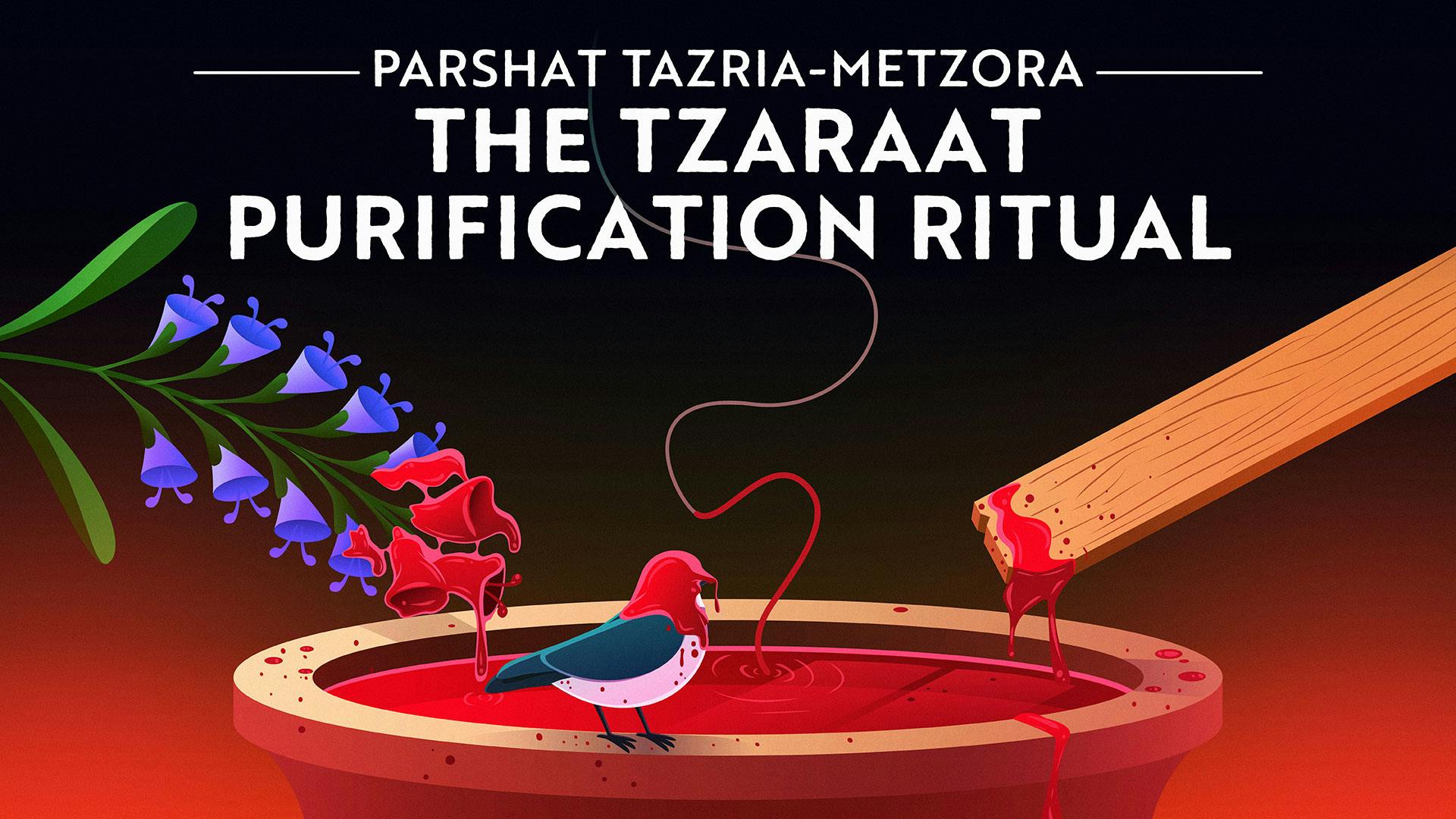
D’var Torah Parshat Metzora
Tzara’at: What Is the Deeper Meaning?
BY Evan Weiner | April 4, 2024 | 5 Minute Read
The Laws of Tzara’at
Parshat Tazria and Parshat Metzora focus primarily on the laws of tzara’at. Throughout these two parshiyot, the Torah outlines the intricate laws of these strange lesions: how a kohen (priest) identifies if it is indeed tzara’at, what happens to a person when he does have tzara’at, and the steps one needs to take to purify oneself from tzara’at. The Torah spends so much time going through the laws of tzara’at, basically two whole parshiyot. The length, breadth, and depth to which the Torah goes into these laws seems like a lot. What is so important about these laws that requires the Torah going into so much detail?
And what’s crazy is that for all the detail the Torah goes into about tzara’at, the most important details are left out, which are how and why one gets tzara’at in the first place. The Torah’s silence on this has actually led to some wild theories about what tzara’at really is. There’s even a wide-spread, but mistaken, belief that tzara’at is leprosy and all the laws are meant to prevent the spread of this contagious disease. This notion is inaccurate – tzara’t is not a physical disease as evidenced by the fact that it can appear on inanimate objects, like clothing and buildings, which is something that physical diseases can’t do. Rather, tzara’at is a unique, spiritual malady, and if that is true, it would make sense for the Torah to emphasize to us why someone would get tzara’at or what lessons we are meant to learn from these laws. But despite the lengthy discussion about tzara’at in these parshiyot, the Torah never comes right out and tells us.
However, if we look closely at the laws of tzara’at, particularly the consequences of getting tzara’at and the bizarre purification process, and see them with fresh eyes, we can put together an understanding of the deeper spiritual significance of tzara’at.
The consequences of tzara’at
The Torah is very explicit that there are two important consequences of having tzara’at: isolation and tumah (impurity). Firstly, a metzora, someone who has tzara’at, is commanded to sit outside the camp by himself. He’s separated from the rest of the community. It kind of feels like a cruel way to treat someone who's probably freaking out about these skin lesions…leave your home, go beyond the city limits, and just sit all alone with no one to talk to! Why should this solitary confinement be the consequence for a metzora?
Secondly, the other result of tzara’at is that the metzora becomes tameh (impure). There are of course, many things that the Torah defines as tameh, but there is something unique about how intensely tameh the metzora is. Well, it’s not entirely unique, because there’s one, and only one, other item that has the same serious degree of impurity as a metzora: a corpse. Why would a metzora and a dead body have the same status? Is there something about a metzora that is dead or dead-like?
The purification process
The real key to unlocking the deeper meaning of tzara’at emerges when you examine a part of the tzara’at laws that is often overlooked: That is, the purification process a metzora goes through after they are cleared from having tzara’at. After the metzora sits outside the camp in isolation, he must be examined by a kohen (priest). If he is given the go ahead that his tzara’at has gone away, then he begins the purification procedure. The process involves taking two birds, cedar wood, scarlet string, and a hyssop branch. One of the birds is slaughtered and its blood is added to a bowl of fresh water. Then the other ingredients are dipped into this bloodied water and sprinkled on the metzora. After this, the remaining bird is set free, and the metzora is purified, but must still stay outside his tent for seven days. This procedure seems so strange. It’s the kind of thing you’d expect to find in a witchcraft manual, so what is it doing in the Torah? Why in the world did the Torah outline this strange process? What is the deeper meaning behind it?
The Deeper Meaning
Rabbi David Fohrman explores all these questions and develops a whole new, fascinating understanding of the deeper meaning behind tzara’at. Watch this video in which he suggests that the strange purification process has resonances to another, earlier procedure the Israelites did involving some of the same ingredients. His unique analysis will reveal incredible meaning hidden just beneath the surface of the text. Subscribe now to enjoy all of Rabbi Fohrman’s mind blowing divrei Torah.
Parshat Metzora in Nutshell
Parshat Metzora begins with the purification process for the metzora. This process involves three stages: the ritual sprinkling using two birds, a piece of cedar wood, a scarlet thread, and a hyssop branch. In the second stage, the metzora must shave off all his hair. In the final stage, the metzora brings various korbanot, offerings. After detailing the purification process, the parsha discusses cases of tzara’at found on a house or building. The final chapter of the parsha teaches the laws of four types of bodily emissions that cause a state of tumah: ba’al keri, niddah, zav, and zavah.
More Metzora Videos

The Meaning Behind The Mikvah Rituals
Video • 15 min
Why do we go to the mikvah? Why does dunking in the mikvah’s waters leave us feeling “pure”? Join us as we take a deeper look at the meaning of this ritual bath and breathe new life into this mysterious custom.

What Does The Passover Sacrifice Teach Us About The Metzora?
Video • 12 min
In this video, Rabbi Fohrman picks up from last year's Tazria and Metzora videos, which connected the metzora purification process with the korban pesach. Here, he argues that only through the two processes can we become fully alive and part of the community.

What Do Tumah And Tahara Mean Today?
Video series • Part 1 of 2 • 11 min
In Parshat Tazria, we are introduced to the concepts of Tumah and Tahara. Some translate them as cleanliness and uncleanliness, some say ritual purity and impurity, but we never seem to get a clear and relevant understanding of what they actually are. Join us in Part I of this quest as we begin to tackle both what Tumah and Tahara are, and how these new definitions can truly impact our lives today.

What Does Childbirth Have In Common With Leprosy?
Audio • 24 min
In Parshat Tazria-Metzora, we learn about the different ways that one can become “tamei,” spiritually impure – such as giving birth, to someone who has contracted leprosy. But how do these radically different ways of becoming tamei actually connect? Are we meant to believe that the miracle of birth is similar to a plague of deformity? Join Rabbi Fohrman and Imu as they reexamine the text and find thematic connections to explain how these strange laws are actually connected.
More Metzora Guides

Tazria-Metzora: Rejoining The Community
Printable Guide
A printable parsha guide for our Tazria-Metzora video, "Rejoining The Community."

Metzora: Living Within the Community
Printable Guide
A printable parsha guide for our Metzora video, "Living Within the Community."

What's Impure About Giving Birth?!
Printable Guide
A self-study guide for: What's Impure About Giving Birth?!
Metzora Pages
What is Aleph Beta?
Aleph Beta is a unique kind of Torah library. Led by our founder, Rabbi David Fohrman, we are dedicated to high-level, textual Torah learning for adults that is intellectually and spiritually sophisticated, that enlivens your Jewish practice and helps you forge a deeper connection to God. Whether you’ve been learning in yeshiva for years or you’re just beginning your Torah journey, you’re sure to find something meaningful and surprising waiting for you here.
Browse our library of over 1,000 beautifully produced animated videos, podcasts, deep dive courses, and printable guides. Topics include the weekly parsha, Jewish holidays & fast days, laws & mitzvot, prayers, relationships, big philosophical ideas and more. Have something to say at the Shabbos table that will amaze your family and guests and bring deep meaning into their lives.


